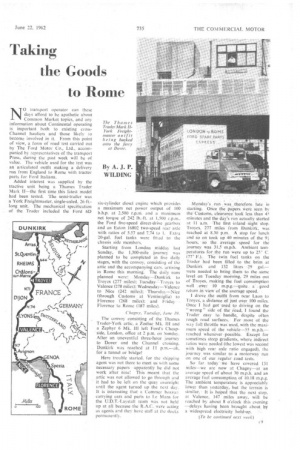Taking the Goods to Rome
Page 39

If you've noticed an error in this article please click here to report it so we can fix it.
NO transport operator can these days afford to be apathetic about Common Market topics, and any information about Continental operating is important both to existing crossChannel hauliers and those likely to become involved in it. From this point of view, a form of road test carried out by The Ford Motor Co., Ltd., accompanied by representatives of the transport Press, during the past week will he of value. The vehicle used for the test was an articulated outfit making a delivery run from England to Rome with tractor parts for Ford ltaliana.
Added interest was supplied by the tractive unit being a Thames Trader Mark 11--the first tirrie this latest model had been tested. The semi-trailer was a York Freightmaster, single-axled, 26-ft.long unit. The mechanical specification of the Trader included the Ford 6D six-cylinder diesel engine which provides a maximum net power output of 100 b.h.p. at 2,500 r.p.ni. and a maximum net torque of 242 lb.-ft. at 1,500 r.p.m., the Ford five-speed direct-drive gearbox and an Eaton 16802 two-speed rear axle with ratios of 5.57 and 7.74 to I. F.xtra 20-gal, fuel tanks were fitted to the chassis side members.
Starting from London midday last Sunday, the 1,300-mile journey was planned to be completed in five daily stages, with the convoy, consisting of the artic and the accompanying cars, arriving in Rome this morning. The daily runs planned were: Monday•Dunk irk to Troyes (277 miles): Tuesday-=-Troy es to Valence (278 miles); Wednesday—Valence to Nice (242 miles); Thursda—Nice (through Customs at Ventimiglia) to Florence (268 miles); and FridayFlorence to Rome (187 miles).
Chagny, Tuesday, Jane 19, The convoy consisting of the Thames Trader-York artic, a Zodiac Mk. III and a Zephyr 6 Mk. III left Ford's Cheap side, London, office at 2 p.m. on Sunday. After an uneventful three-hour journey to Dover and the Channel croisine, Dunkirk was reached at II p.m.—oh, for a tunnel or bridge!
Here trouble started, for the shipping agent was not there to meet us with some necessary papers apparently he did not work after nine! This meant that the artic was not allowed to go through and it had to be left on the quay overnight until the agent turned up the next day. It is interesting that a Commer boxvan carrying cars and parts to I.e Mans for the U.D.TAaystall team was not held up at all because the R.A.C. were acting as agents and they have staff at the docks permanently.
Monday's‘. run was therefore late in starting. Once the papers Were seen by the Customs, Clearance' took less than 45 minutes and the day's run actually started at 11 'aim • The first inlandflight stop. Troyes, 277 miles from .Dunkirk, was reached at 8.30 p.m. A stop for lunch and so on took up 40 minutes of the 97; hours, so the average' speed for the journey. was 31.5 m.p.h. Ambient temperatures for the run were up to 25° C. (77° F.). The twin fuel tanks on the Trader 'had been filled to the brim at Dunkirk and 132 litres-24 gal.— were needed to bring them to the.same level on Tuesday morning, 29 miles out of troyes, making .the fuel consumption
well .oVer 10 m.p.g.—:quite., . good return in view of the average speed.
I .drove the outfit from near Laon to Troye, a distance of just oVer 100 miles. Once I had got 'used to driving on the " wrong" side of the road, I found the Trader easy to handle, • despite often rough road surfaces. For most of the way full throttle Was' used, with the maximum speed of the vehi4le-55 m,p.h.— reached whenever -possible. Except for sometimes steep gradients, where indirect ratios were needed (the lowest was second with high rear axle ratio engaged), the journey was similar to a motorway run on one of our. regular road tests.
So far, today we have covered, 131 miles--we are now at Chagny—at an average speed of about 30 m.p.h. and an average fuel consumption of 10.18 rn,p.g. The ambient temperature is appreciably lOwer than yesterday, hut the terrain is similar. • It is hoped that the next stop, at Valence, 147 miles away, will be reached by about 8 o'clock this evening --delays having been brought about by a 'widespread electricity hold-up.
(To be continued next 11,,eck)












































































































